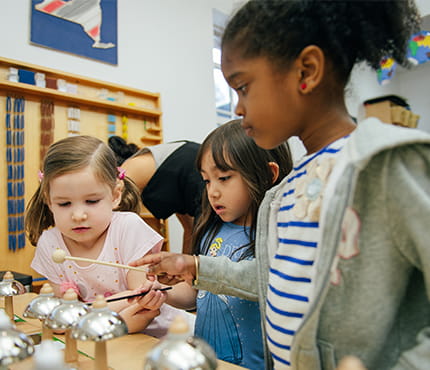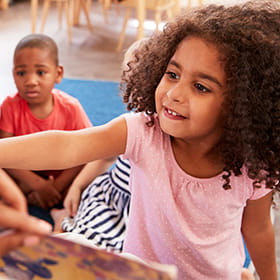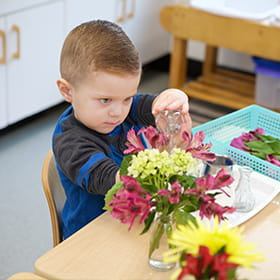Retaining Your Child in Montessori School
The advantages of continuing with Montessori.

Taking Time to Learn Together
In the first Casa dei Bambini (Children’s House) founded by Dr. Maria Montessori in 1907, teachers worked with children ages 2½ through 6. Dr. Montessori noted the benefits of children of different ages working and learning together in the same community. Much as in a family, she noted, older students helped younger students within the environment, and both older and younger students benefited. The multi-age classroom became an important tenet of the Montessori Method.
The Montessori Method is also known for its 3-year cycle of learning. Children stay together, often with the same teacher, for that extended period, getting to know one another and themselves as they grow. Older children become mentors and leaders; younger children look up to and learn from older classmates as well as their teachers. As each cycle is completed, children have the opportunity to rise up to the next level.
If your young child begins his or her schooling in a Montessori environment—whether it is a program for infants and toddlers or Early Childhood (preschool and Kindergarten)—you may be curious about the advantages of committing to Montessori beyond those very early years. You may also wonder about the move from a Montessori Elementary program into Montessori Secondary school.
Moving Up from Infant & Toddler Programs
Even the youngest children in a Montessori environment are offered freedom of choice in the learning environment, gently guided by teachers. As they develop and transition from Infant programs (for children birth – 18 months) and into programs for Toddlers (18 months – age 3), they are ready to move on to the more intentional structure of Early Childhood, where they will spend the next 3 years of their growth with another multi-age group of classmates.
In a Montessori environment, your infant or toddler will be with teachers who create peaceful, supportive, and safe environments for our youngest children. In these spaces, a child’s natural passion for wonder, curiosity, exploration, independence, and discovery comes alive.

What will your baby learn in a Montessori program?
Early Childhood, Including Kindergarten
Working with younger children heightens older children’s leadership skills. In the third year of Early Childhood education, the Kindergarten year, a child is engaged as a leader in his or her classroom community—a foundational experience that develops lifelong leadership skills. In the Kindergarten year, a child’s learning from the previous 2 years in the Early Childhood classroom is fully exhibited and exercised.
During the Kindergarten year, curriculum continues to be developmentally attuned to your child’s ability level. Kindergarteners are introduced to advanced academic concepts that prepare them for their Elementary years. At the conclusion of Kindergarten, they are fully ready to rise up to Elementary.
On to Elementary
Making the decision to continue in Montessori through the Elementary years offers your child many of the same benefits of the Early-Childhood years, but they are exhibited in a different way. This is the time that children are exposed to “big ideas” and Elementary children are naturally drawn to the topics. Exploration of these topics is often dictated by the child’s own interests, which in turn provides deeper engagement. Along the way, their peers become interested, and the child will naturally share what they have learned. Often children are encouraged to give formal presentations of their project providing opportunities for children to speak in front of a friendly group early on.
Elementary Montessori teachers take advantage of the older child’s preference to work in small groups. Often the lessons are designed so that children have multiple opportunities to hear other people’s ideas, perspectives, and thought processes. This provides children with the concept that there are multiple ways to think through an idea, and encourages creative thinking and problem solving.
Students in Elementary are still working at their own pace and may make work choices in conjunction with their peers. Collaboration and cooperation are encouraged and expected in the Elementary environment. Being exposed to multiple ways to complete a project allows children to develop social-emotional skills in tandem with learning the content. Children work on mastery of a skill and are encouraged to continue learning without the competitive structure of grades.
The ability to continue to learn at one’s own pace, to explore one’s unique interests, and the emphasis on whole-child development (academic, physical, social, and emotional) characterizes the joyful Elementary years in Montessori.
Montessori Elementary programs serve children ages 6 – 12.

The Montessori Secondary Classroom
Montessori options continue through the Secondary level—that is, Middle School and High School. The Montessori Secondary classroom provides a prepared learning environment for adolescents that integrates vigorous student-centered academic studies with purposeful work, preparing them to become contributing adult citizens who are self-confident and possess skills needed to thrive in society.
Adolescent communities allow opportunities for collaborative work and student leadership through:
- Daily student-led community meetings
- Activities, such exploring philosophical questions through Socratic discourse, inquiry-based problem solving, and applied scientific method, that encourage diversity of perspectives, thoughts, and learning styles
- A community within the classroom that encourages participation in classroom government and offers other leadership opportunities
Montessori Secondary programs promote responsible and ethical use of technology, with the majority of the school day spent in learning activities and practices that require peer-to-peer and student-teacher interaction rather than screen time.
The Montessori Secondary curriculum is characterized by interconnections that deepen learning, including:
- Micro-economic experiences such as developing and running a business or selling produce at a farmer’s market that promote a genuine understanding of currency and the value of work.
- Field work that may include land labs, camping, internships, service learning, entrepreneurship, and outdoor education trips.
Moving On from Montessori
A time may come when your child will have to move on from Montessori. Perhaps he is graduating from a Secondary program, or there may be no options in your area for Montessori at his next grade level.
How will your child handle the transition to a non-Montessori classroom?
Children are adaptable. Poised, self-reliant, and used to working harmoniously as part of a classroom community, students who move on from Montessori typically adjust quickly to the ways of their new school.
By and large, the skills of most Montessori children are on par or above the academic skills of other children. Often, children from Montessori environments exhibit maturity above that of their peers. This is generally because Montessori students have been given the opportunity to make independent choices early on within the context of a multi-age peer group. Additionally, Montessori students tend to exhibit strong citizenship and leadership skills. They are accustomed to being responsible and contributing members of their communities.
Children who transfer out of a Montessori school are likely to notice some differences. For example, instead of choosing their own work to investigate and master, they might have to learn what’s on the teacher’s lesson plan. Instead of moving freely around the classroom, there’s a chance they will sit in an assigned seat. Instead of learning in a classroom with a mixed-aged grouping, it’s likely they will be placed just with students their own age. Some children may find it challenging to adjust to a more hierarchical structure where they must comply with an adult’s requests in the adult’s timeframe.
The older the child, the easier it will be to navigate these new waters. Generally, teachers in other environments appreciate the children’s or adolescents’ leadership skills and self-motivation and are impressed by their independent learning, organization, and time management skills. Carrying the Montessori Method with them, these learners thrive.




